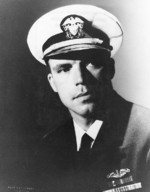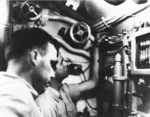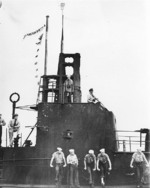Dudley Morton
| Surname | Morton |
| Given Name | Dudley |
| Born | 17 Jul 1907 |
| Died | 11 Oct 1943 |
| Country | United States |
| Category | Military-Sea |
| Gender | Male |
Contributor: C. Peter Chen
ww2dbaseDudley Walker Morton was born in Owensboro, Kentucky, United States in 1907. He graduated from the United States Naval Academy in Annapolis, Maryland, United States in 1930; while at the academy, he acquired the nickname "Mushmouth", later shortened to "Mush", after a character in the cartoon strip Moon Mullins whose large square jaw and prominent mouth resembled those of Morton's. Between the early 1930s through mid-1942, he served aboard USS Saratoga, USS Chicago, USS Canopus, USS Fairfax, USS S-37, and USS R-5, the last of which as the commanding officer. In Oct 1942, he was promoted to the rank of lieutenant commander while in nominal command of USS Dolphin, which at the time was under repairs at Pearl Harbor in US Territory of Hawaii. In Nov 1942, he was relieved of that position in order to become the prospective commanding officer of USS Wahoo; he officially received that command on the final day of 1942 while in Australia. Between Jan and Oct 1943, he led USS Wahoo on four war patrols, during which the submarine sank 19 ships for a total of 55,000 tons.
ww2dbaseThough those numbers were impressive, Morton's career was marred by the Buyo Maru incident of 26 Jan 1943, in which he ordered his men to fire upon 20 lifeboats containing survivors of the Japanese transport Buyo Maru, an action that was in clear violation of the Hague Convention of 1907. US Navy defended Morton and his executive officer Richard O'Kane, claiming that the survivors of Buyo Maru were Japanese Army troops and they had opened fire with rifles and machine guns on the American submarine, thus USS Wahoo was justified in returning fire. It was later foudn out that some of the surivors that USS Wahoo's crew fired upon included prisoners of war of 16th Punjab Regiment of Indian 2nd Battalion, thus Morton's order might had resulted in the death of Allies.
ww2dbaseIn mid-Oct 1943, while making a patrol in the Sea of Japan, USS Wahoo became missing and was presumed lost. After the war, a study in Japanese records revealed that USS Wahoo was sunk by an anti-submarine aircraft with three depth charges in Soya Strait between Hokkaido island and Sakhalin island on 11 Oct 1943.
ww2dbaseIn 1960 Vice Admiral Charles Lockwood wrote about Morton (in the foreword for the book Wake of the Wahoo) "[w]hen a natural leader and born daredevil such as Mush Morton is given command of a submarine, the result can only be a fighting ship of the highest order, with officers and men who would follow their skipper to the Gates of Hell.... And they did." O'Kane, who witnessed the Buyo Maru Incident as a participant, noted that had it not been that incident that left a black mark on Morton's records, Morton probably would have been nominated for a Medal of Honor.
ww2dbaseForrest Sherman-class destroyer DD-948 was named in Mush Morton's honor in 1959.
ww2dbaseSources:
Dan van der Vat, Pacific Campaign
Wikipedia
Last Major Revision: May 2005
Dudley Morton Interactive Map
Photographs
 |  |  |  |
Dudley Morton Timeline
| 17 Jul 1907 | Dudley Morton was born in Owensboro, Kentucky, United States. |
| 19 Aug 1940 | Dudley Morton was named the commanding officer of USS R-5. |
| 23 Apr 1942 | Dudley Morton stepped down as the commanding officer of USS R-5. |
| 15 Oct 1942 | Dudley Morton was promoted to the rank of lieutenant commander. |
| 8 Nov 1942 | Dudley Morton was made the prospective commanding officer of USS Wahoo. On the same day, USS Wahoo departed Pearl Harbor, US Territory of Hawaii for her second war patrol. |
| 31 Dec 1942 | USS Wahoo completed her scheduled overhaul at Brisbane, Australia. On the same day, Commander Dudley Morton replaced Lieutenant Commander Marvin Kennedy as the commanding officer. |
| 26 Jan 1943 | USS Wahoo attacked a Japanese convoy of four freighters in the Pacific Ocean, sinking transport Fukuei Maru, sinking transport Buyo Maru, and damaging another transport. 11 torpedoes were expended, 7 of which hit. She then surfaced to attack Japanese survivors in lifeboats; this last action would generate some controversy, especially that some of the survivors killed included Indian prisoners of war. Six hours later, she began a three-hour pursuit of the two remaining ships of the Japanese convoy, eventually sinking both (a tanker and a freighter), hitting them with 3 of 8 torpedoes. |
| 21 Jun 1943 | Dudley Morton was awarded the Navy Cross. |
| 11 Oct 1943 | USS Wahoo was sunk by Japanese anti-submarine aircraft in Soya Strait (La PĂ©rouse Strait) between Hokkaido and Karafuto (Sakhalin), Japan. All aboard, including commanding officer Dudley Morton, were killed. |
| 7 Jan 1946 | Dudley Morton, lost aboard USS Wahoo off Hokkiado, Japan in Oct 1943, was officially declared deceased. |
Did you enjoy this article or find this article helpful? If so, please consider supporting us on Patreon. Even $1 per month will go a long way! Thank you. Share this article with your friends: Stay updated with WW2DB: |
Visitor Submitted Comments
16 Feb 2014 07:20:54 AM
He should be tried for felonies war. He shot at Japanese soldiers saving themselves after sinking a cargo ship. He killed of them from the machine-made weapon. It is a war crime.
17 Jul 2017 08:17:14 AM
After boot camp I traveled to San Francisco. The Wahoo pulled into Mare Is., I believe for a n overhaul. Two of our group were chosen as crew members, none of them served in a relief crew. We met both at Pearl Harbor after the patrol. One got off to attend a srvice school and the other was lost on that fateful patrol
25 Apr 2021 05:22:41 PM
War criminal, all recognitions of him being a war hero should be abolished as the order the killing of 100 Japanese merchant navy sailors.
All visitor submitted comments are opinions of those making the submissions and do not reflect views of WW2DB.
» Wahoo
- » 1,150 biographies
- » 337 events
- » 43,917 timeline entries
- » 1,241 ships
- » 350 aircraft models
- » 207 vehicle models
- » 374 weapon models
- » 123 historical documents
- » 260 facilities
- » 470 book reviews
- » 28,543 photos
- » 432 maps
Winston Churchill
Please consider supporting us on Patreon. Even $1 a month will go a long way. Thank you!
Or, please support us by purchasing some WW2DB merchandise at TeeSpring, Thank you!
19 Jul 2005 04:27:21 PM
American policy during the Pacific naval war prohibited
the killing of helpless soldiers, but where they were sure to be rescued and put back into combat, as was the case at Empress Augusta Bay, it was sanctioned. Morton did what he had to do, as did the various aircraft that attacked survivors in the water. The Japanese defined the nature of the war very early on by refusing to treat prisoners according to international law, murdering them by the thousands at Bataan and showing no mercy at all to any of those they conquered. It was a nasty war and we must all learn from the atrocities committed by all sides. GLS